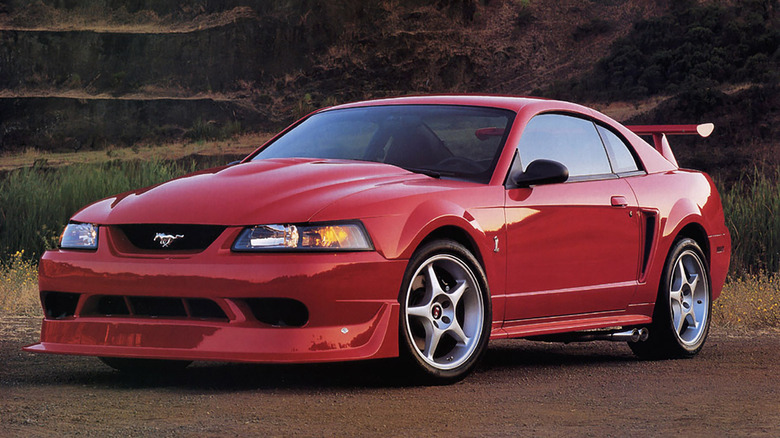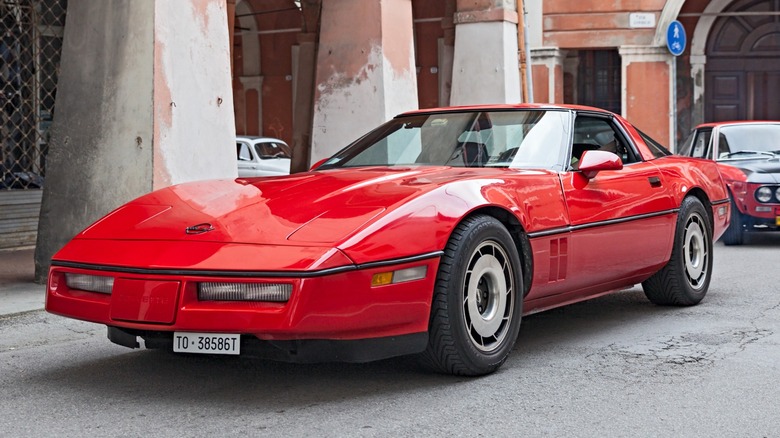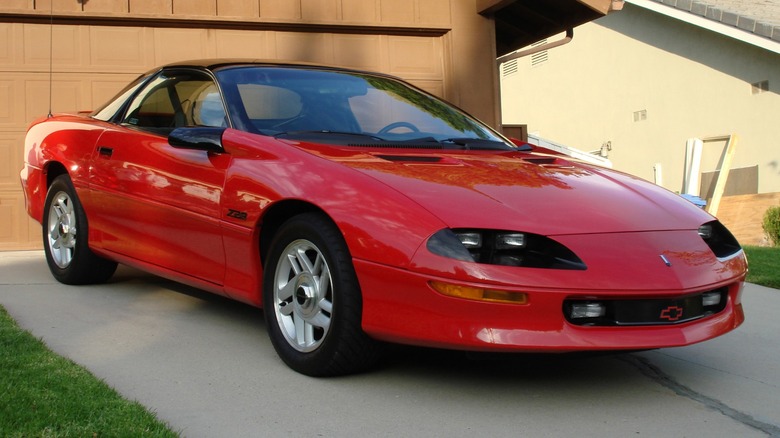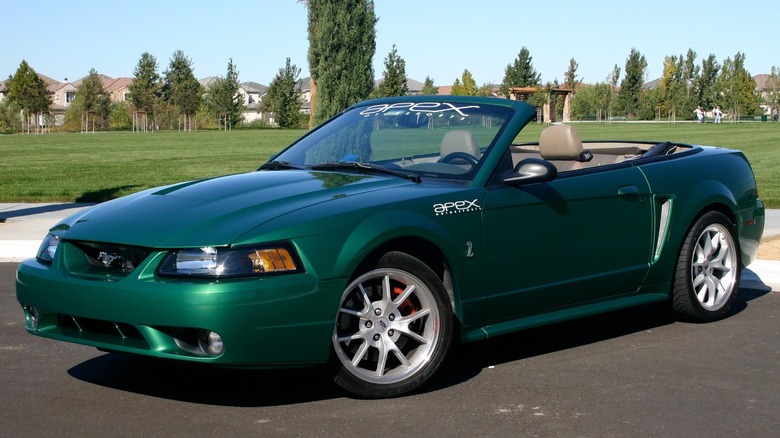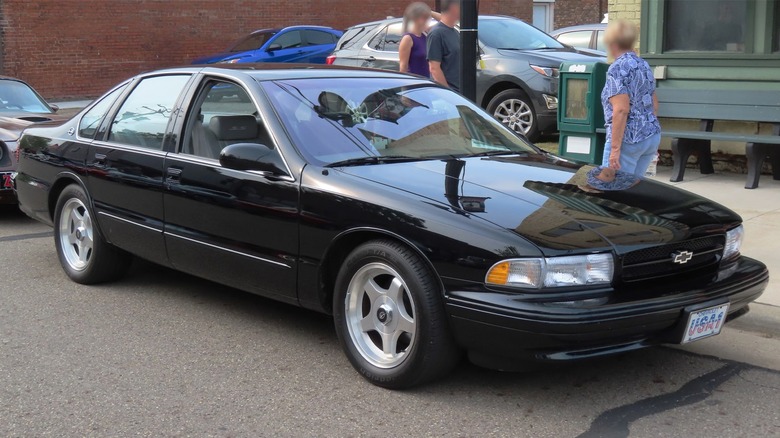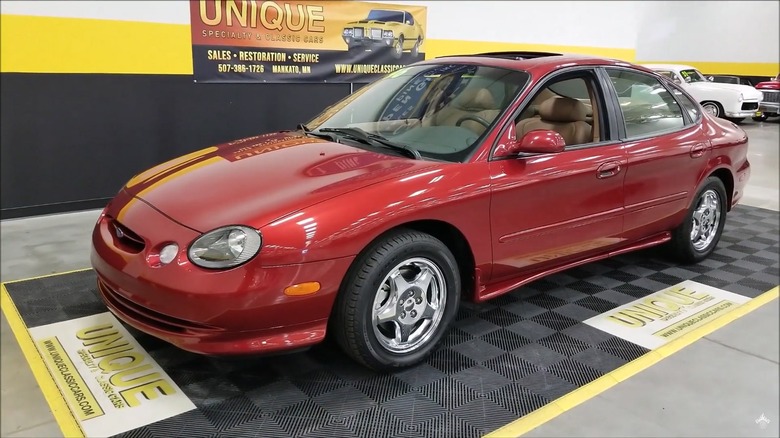5 Of The Highest Horsepower Muscle Cars Of The 1990s
The muscle car era began in 1949 with the Oldsmobile Rocket 88 — a full-sized car featuring the lighter body of the Oldsmobile 70 and a more powerful V8 engine — one of the most important moments in Oldsmobile history. The muscle car became a phenomenon in the following years, with the big three — Chrysler, Ford, and General Motors — launching their own models and other smaller manufacturers like AMC following suit.
However, the 1973 oil crisis, along with more stringent safety and environmental regulations, dampened advancements in muscle car development. It wasn't until the late 1980s that muscle cars started regaining their panache, especially with the introduction of the Buick GNX.
By the 1990s, muscle cars were becoming faster again. The technology has advanced to a level where we now enjoy fast, powerful vehicles that are safe, have good fuel economy, and pollute less. So, which muscle cars made the greatest comeback after the malaise era?
[Featured image by Spunjo via Wikipedia| Cropped and scaled | Public Domain]
1995 C4 Chevrolet Corvette ZR1
Many purists do not consider the Corvette a muscle car. However, if we adhere to a strict definition of a muscle car, we would have only one or two models on this list. Nevertheless, given the heritage and iconic status of the Chevrolet Corvette, we can't help but include it.
While the C5 Corvette launched in 1996, its high-performing Z06 version did not debut until 2001. Therefore, we must choose the C4 Corvette ZR1 to represent the most powerful Corvette. It's also the best-value Corvette you can get your hands on if you want to add a classic to your car collection.
The ZR1's last model featured a 5.7-liter LT1 V8 engine that delivered 405 hp at 5,800 rpm and 385 lb-ft of torque at 5,200 rpm. This is an astounding power output for its time, making it one of the most powerful muscle cars of the '90s.
1998 Chevrolet Camaro Z/28 SS
Some say the Chevrolet Camaro is one of the three modern muscle cars you can buy in the 2020s. However, it swapped the usual boxy look of a muscle car for a sleeker design in the '80s and '90s. Nevertheless, we still consider the Camaro a muscle car because of its pedigree and performance.
The fourth-generation Camaro, sometimes referred to as the "Catfish Camaro" due to its polarizing look, was available from 1993 to 2002. Although the Z28 SS was launched in 1996, it received the more powerful LS1 engine in 1998, making it the highest horsepower muscle car in the '90s Camaro lineup.
The LS1 engine in the '98 Camaro Z/28 SS is a V8 powerhouse, capable of delivering 320 hp at 5,200 rpm and 335 lb-ft of torque at 4,000 rpm. Not to mention, its 0-60 mph time clocked in at just 5.2 seconds — a record for the late 90s. It had a 13.6-second quarter mile, reaching a top speed of 106.5 mph, and it could come to a complete stop from 60 mph in just 120 feet.
[Featured image by Rich Niewiroski Jr. via Wikipedia| Cropped and scaled | CC-BY-2.5]
1999 Ford Mustang SVT Cobra
Of course, when we talk about muscle cars, we can never overlook the Ford Mustang. This is one of, if not the only, muscle car that has been in continuous production since the 1960s. In fact, it's so iconic that when Ford stopped making cars in the U.S., it retained the Mustang on its production line.
The most powerful Mustang variant is the SVT Cobra, ranking above the Mustang GT and the Mach 1. But even after launching the fourth-generation Mustang, Ford continued to improve the variant to produce more power. When Ford facelifted the fourth generation with the New Edge design, they released the most powerful variant yet.
The 1999 Ford Mustang SVT Cobra featured a 4.6-liter V8 engine capable of producing 320 hp at 6,000 rpm and 317 lb-ft of torque at 4,750 rpm. Although the company released an even more powerful Mustang, the SVT Cobra R, in 2000, this was already in the new millennium, so it doesn't count for the 90s.
[Featured image by Sunstarfire via Wikipedia| Cropped and scaled | CC-BY-SA 3.0]
1996 Chevrolet Impala SS
The Impala is another model with a great legacy from the 50s. Although it didn't have the honor of being continuously produced like the Mustang, it's still an iconic car, especially when it carried the SS badge from 1961 to 1969.
Chevrolet discontinued the Impala in 1985 but relaunched it in 1994 as the Impala SS. Although it was essentially a high-performance Caprice based on the police package Chevy sold to law enforcement, it was still a great muscle car, as police units typically demand powerful and reliable engines for their fleets.
You can expect a fast and robust car if you own the 1996 Chevrolet Impala SS. Its 5.7-liter LT1 V8 engine delivers 260 hp at 5,000 rpm and 330 lb-ft of torque at 2,400 rpm. According to MotorTrend tests, the Impala SS can go from zero to 60 mph in seven seconds flat and complete the quarter-mile in 15.4 seconds. This may not sound like much today, but it was definitely a record back in the mid-'90s.
[Featured image by MercurySable99 via Wikipedia| Cropped and scaled | CC-BY-SA 4.0]
1999 Ford Taurus SHO
Another four-door muscle car example is the Ford Taurus SHO. This model was launched in 1989 and featured a Yamaha-designed Ford SHO V6 engine — with SHO meaning Super High Output. Although the most iconic models were from 1992 to 1995, they weren't exactly the most powerful models made in the '90s.
This award goes to the third-generation Ford Taurus SHO, which was produced from 1996 to 1999. Although it didn't have a sharp look, it was the most powerful model yet. It was also the only one to feature a V8 engine but lost the manual transmission option. So, if you wanted one, you had to stick to the four-speed AX4N automatic transmission.
Nevertheless, the 1999 Ford Taurus SHO's 3.4-liter SHO V8 engine could output 235 hp at 6,100 rpm and 230 lb-ft of torque at 4,800 rpm. Automobile Catalog recorded its zero to 60 mph performance in 7.3 seconds and completed a quarter-mile in 15.4 seconds at 91 mph.
Although the muscle car no longer existed in its purest form in the 1990s, several American cars from that era could deliver the exhilarating straight-line performance muscle cars are known for, but this time, with more comfort, safety, practicality, and usability.
